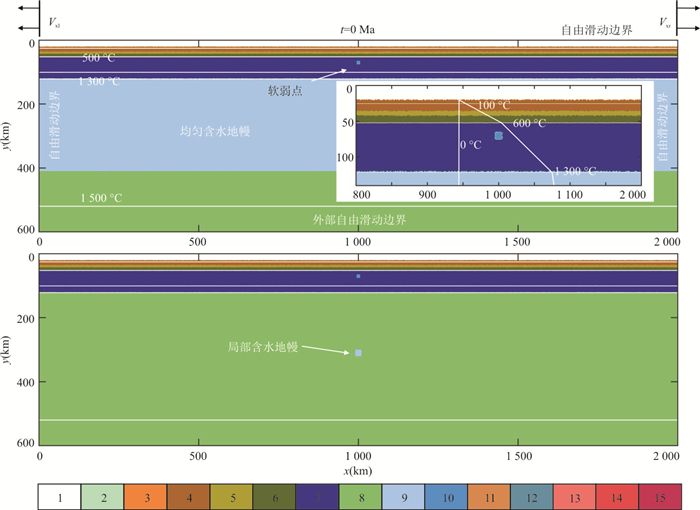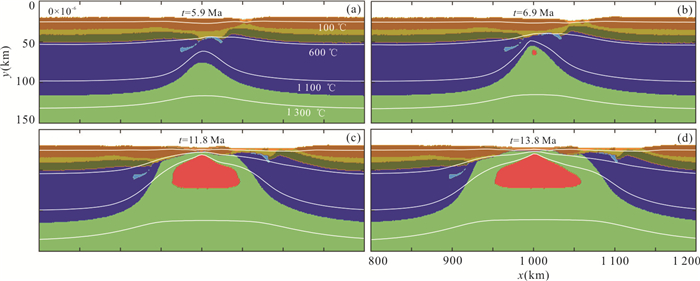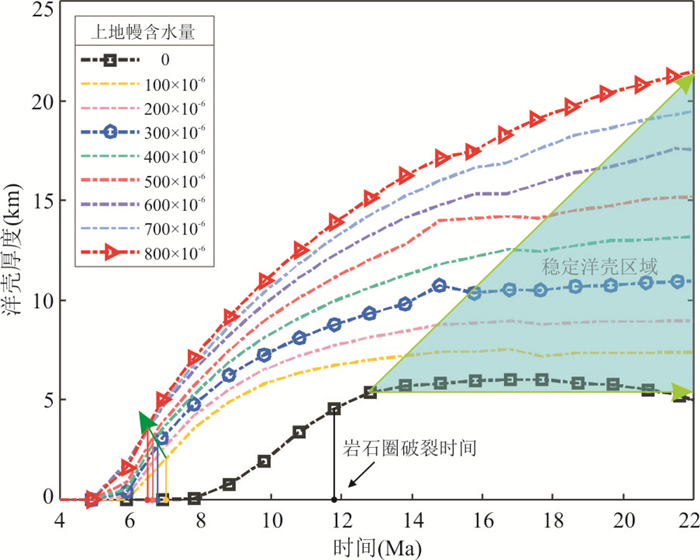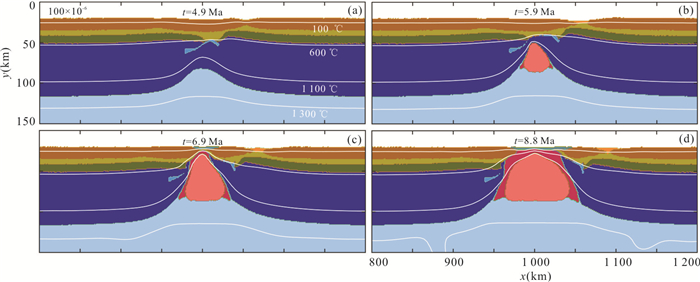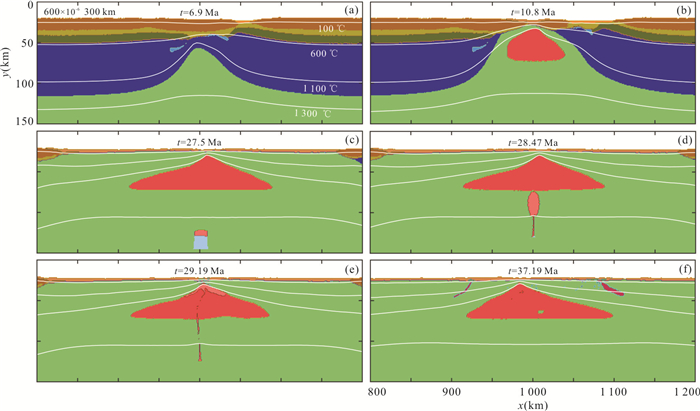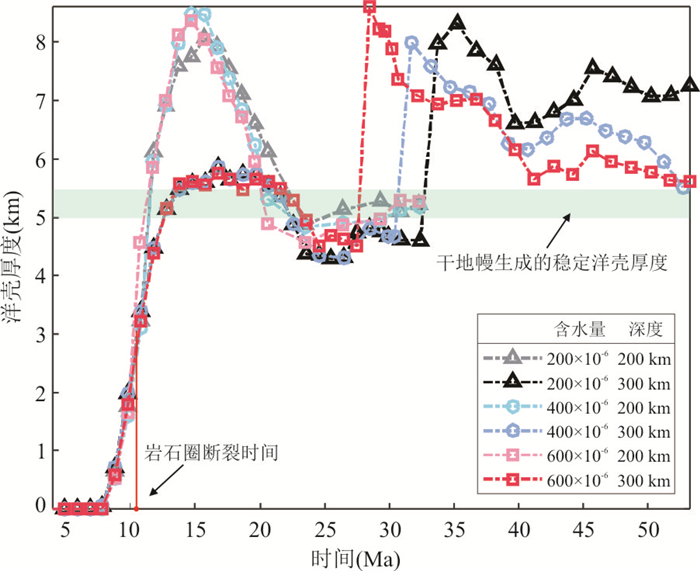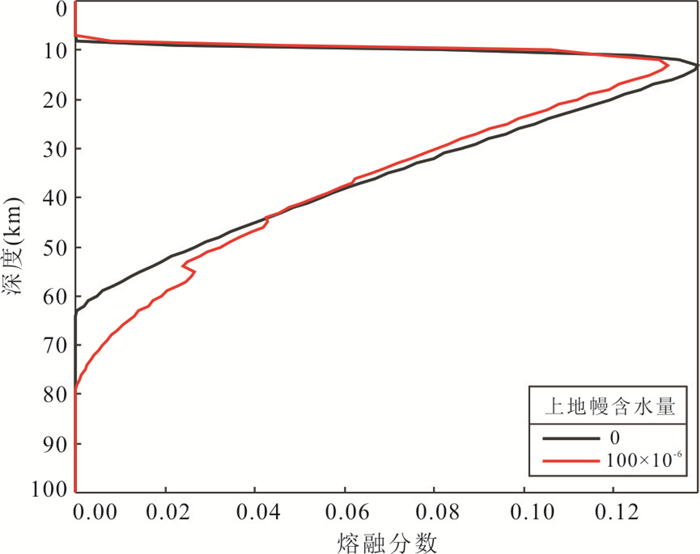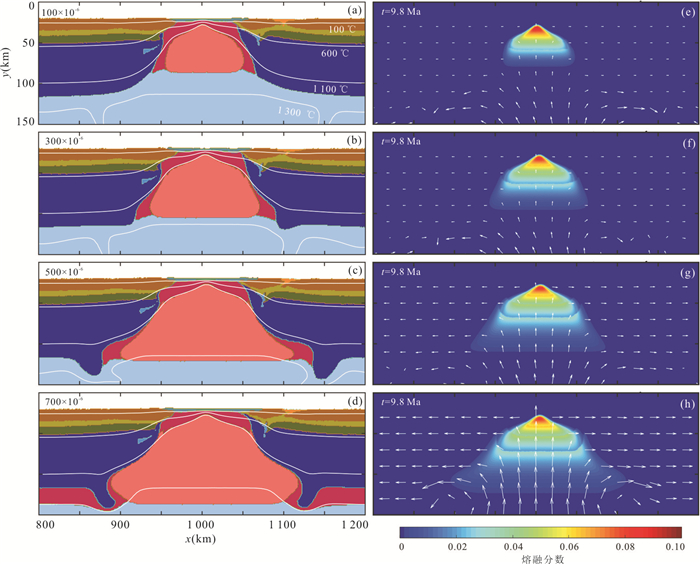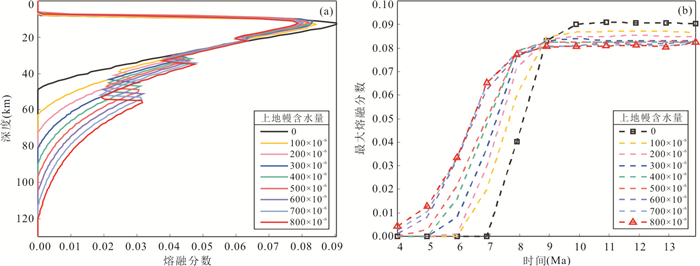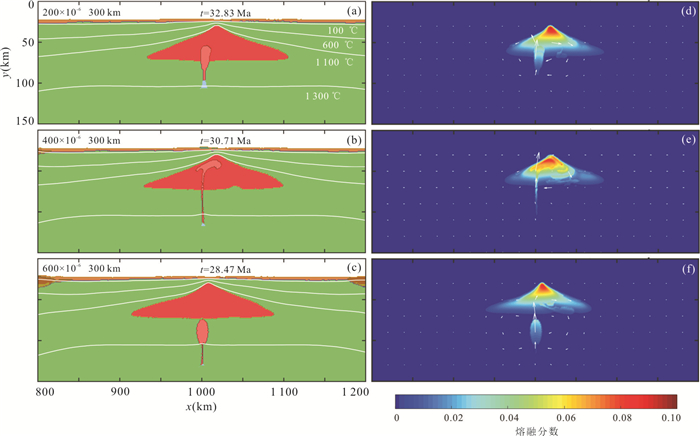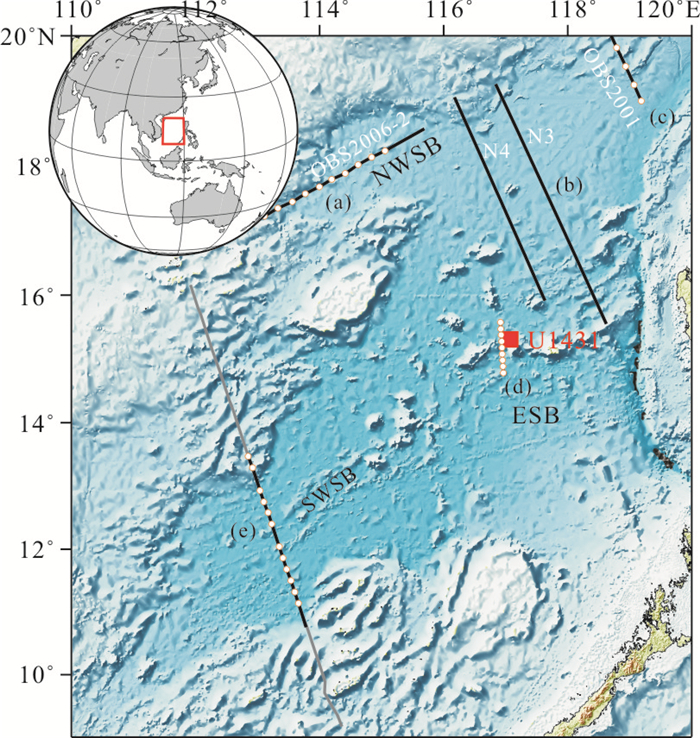The Effect of Water Content in the Upper Mantle on the Oceanic Crustal Thickness during Seafloor Spreading: Numerical Modeling
-
摘要: 地幔中不同含量的水会对洋壳的生成产生重要影响,但目前不同含水量下的均匀和局部含水地幔会怎样影响洋壳厚度还不清楚.利用动力学数值模拟的方法,对上地幔均匀含水和局部含水两种情况下洋壳的生成过程展开研究.结果表明:当上地幔均匀含水时,含水量的增加在减小最大熔融分数的同时,会增大初始熔融深度和熔融面积,因而生成的洋壳厚度会增加.当上地幔局部含水时,局部含水地幔熔融后也会增大生成的洋壳厚度,但开始影响洋壳厚度的时间与其含水量有关.结合南海洋壳特征进一步分析认为:南海扩张期间其地幔源含水量具有非均质性.东部次海盆的洋壳比西南次海盆厚1 km,可能是因为前者地幔源含水量整体高于后者(本模型表明约高50×10-6).南海玄武岩中碳酸盐化硅酸盐熔体的存在,可能是由局部高含水量地幔在深部熔融产生的熔体携带上来的.南海洋壳厚度在时间上没有大幅度变化,可能是因为局部高含水量地幔的体积相对较小或体积虽大但其含水量没有显著高于地幔背景含水量.Abstract: Different contents of water in the mantle have significant effects on the formation of oceanic crust. However, how the homogeneous and local hydrous mantle with different water contents will affect the thickness of oceanic crust are also not clear. Thus we conduct numerical simulations to represent the process of formation. Results show that, in the homogeneous hydrous models, the higher the water content in the upper mantle is, the smaller the maximum melt fraction, the deeper the initiation melting and the bigger melting area will be, finally leading to larger melt volume and the thicker oceanic crust. And in the local hydrous models, the melt of local hydrous mantle can also increase the thickness of oceanic crust, however, the initial time of the effect will depend on its water content. Combining with the characteristics of oceanic crust of the South China Sea, we suggest that the water content in the mantle source during the opening of South China Sea is heterogeneous.The oceanic crustal thickness in eastern sub-basin is 1 km thicker than that of the southwestern sub-basin, possibly because the overall water content of the former is higher than the latter (about 50×10-6, according to our model). And carbonated silicate melts in the basalt of South China Sea may be carried out from deep by the melt which the local hydrous mantle produce in the deep. Moreover, the oceanic crustal thickness does not change greatly with time, which may be due to the volume of the local hydrous mantle is small or the volume is large but its water content is not significantly higher than that in the background.
-
图 1 模型中干、湿地幔相图
图中黑色的标号1的带箭头点画线和标号2、3的带箭头虚线分别示意固体地幔上升路径和含水(800×10-6)、干地幔熔融后上升的路径;蓝色及黄色五角星分别代表含水地幔(800×10-6)和干地幔开始熔融的温度和压力.本图根据Katz et al. (2003)参数化熔融模型绘制
Fig. 1. Phase diagram of dry and wet mantle in the models
图 3 干地幔模型演化结果
图中各颜色含义见图 2;图a表示大陆岩石圈拉张减薄前期,该阶段无地幔熔融体生成;图b表示地幔熔融体开始出现,进入拉张减薄后期;图c表示岩石圈破裂和洋壳开始生成;图d表示洋壳形成阶段
Fig. 3. The evolution results of the dry models
图 5 当均匀含水模型含水量为100×10-6时演化结果
图中各颜色含义见图 2;图a表示大陆岩石圈拉张减薄前期,该阶段无地幔熔融体生成;图b表示地幔熔融体开始出现,进入拉张减薄后期;图c表示岩石圈破裂和洋壳开始生成;图d表示洋壳形成阶段
Fig. 5. The evolution results of the homogeneous hydrous models with 100×10-6 water content
图 6 含水量为600×10-6、初始深度为300 km的局部含水模型随时间演化结果
图中各颜色含义见图 2;图a表示大陆岩石圈拉张减薄前期,该阶段无地幔熔融体生成;图b表示拉张减薄后期结束,岩石圈破裂和洋壳开始生成;图c中局部含水地幔上升至其初始熔融深度并开始熔融;图d中含水地幔完全熔融并迅速上升;图e中含水地幔的熔体与干地幔熔融体混合并增加了地幔熔融量;图f中含水地幔熔体耗尽
Fig. 6. The evolution results of the local hydrous models with 300 km initial depth and 600×10-6 water content
图 9 不同含水量下均匀含水模型在9.8 Ma时的物质组分(a~d)和熔融分数演化(e~h)结果
图a~d代表物质组分,各颜色所代表的含义见图 2;图e~h代表a~d对应的熔融分数分布,白色箭头为物质速度场方向,不同颜色代表熔融分数
Fig. 9. Composition (a-d) and melt fraction distributions (e-h) results of different homogeneous hydrous models with varying water contents at 9.8 Ma
图 12 南海玄武岩样品和部分地球物理测线位置
图中的红色方块点表示发现碳酸盐化硅酸盐熔体的U1431钻孔位置,且其岩石样品含水量较大(Zhang et al., 2017; Wang et al., 2019).黑或灰线代表地球物理测线,其中测线a为OBS2006-2,来自敖威等(2012);测线b为多道地震测线,来自Ding et al. (2018);测线c为OBS2001, 来自Wang et al. (2006);测线d来自张莉等(2013)、He et al. (2016);测线e来自吕川川等(2011)、丘学林等(2011)和Yu et al. (2017);NWSB代表西北次海盆,ESB代表东部次海盆,SWSB代表西南次海盆
Fig. 12. Location of basalt samples and some seismic lines of the South China Sea
表 1 数值实验描述
Table 1. Description of numerical experiments
均匀含水模型 局部含水模型 地幔含水量(10-6) 地幔含水量(10-6) 所在深度(km) 0 — — 100 — — 200 200 200 300 200 300 400 400 200 500 400 300 600 600 200 700 600 300 800 — — 表 2 局部含水模型开始熔融及开始影响洋壳厚度的时间
Table 2. The initial time of local hydrous mantle melting and affecting the oceanic crustal thickness
初始深度(km) 含水量(10-6) 开始熔融时间(Ma) 开始影响洋壳厚度的时间(Ma) 200 200 11.5 11.78 200 400 10.0 11.78 200 600 9.0 11.78 300 200 31.9 32.80 300 400 29.4 30.40 300 600 27.5 28.40 -
Ao, W., Zhao, M. H., Qiu, X. L., et al., 2012. Crustal Structure of the Northwest Sub-Basin of the South China Sea and Its Tectonic Implication. Earth Science, 37(4): 779-790 (in Chinese with English abstract). http://www.researchgate.net/publication/286203459_Crustal_structure_of_the_Northwest_Sub-Basin_of_the_South_China_Sea_and_its_tectonic_implication Asimow, P. D., Langmuir, C. H., 2003. The Importance of Water to Oceanic Mantle Melting Regimes. Nature, 421(6925): 815-820. https://doi.org/10.1038/nature01429 Bell, D. R., Rossman, G. R., 1992. Water in Earth's Mantle: The Role of Nominally Anhydrous Minerals. Science, 255(5050): 1391-1397. https://doi.org/10.1126/science.255.5050.1391 Brunelli, D., Cipriani, A., Bonatti, E., 2018. Thermal Effects of Pyroxenites on Mantle Melting below Mid-Ocean Ridges. Nature Geoscience, 11(7): 520-525. https://doi.org/10.1038/s41561-018-0139-z Chen, Y. J., 1992. Oceanic Crustal Thickness Versus Spreading Rate. Geophysical Research Letters, 19(8): 753-756. https://doi.org/10.1029/92gl00161 Christeson, G. L., Goff, J. A., Reece, R. S., 2019. Synthesis of Oceanic Crustal Structure from Two-Dimensional Seismic Profiles. Reviews of Geophysics, 57(2): 504-529. https://doi.org/10.1029/2019rg000641 Ding, W. W., Sun, Z., Dadd, K., et al., 2018. Structures within the Oceanic Crust of the Central South China Sea Basin and Their Implications for Oceanic Accretionary Processes. Earth and Planetary Science Letters, 488: 115-125. https://doi.org/10.1016/j.epsl.2018.02.011 Gerya, T., 2019. Design of 2D Numerical Geodynamic Models. Introduction to Numerical Geodynamic Modelling. Cambridge University Press, Cambridge. https://doi.org/10.1017/cbo9780511809101.018 Grove, T. L., Till, C. B., Krawczynski, M. J., 2012. The Role of H2O in Subduction Zone Magmatism. Annual Review of Earth and Planetary Sciences, 40(1): 413-439. https://doi.org/10.1146/annurev-earth-042711-105310 Hall, R., 2002. Cenozoic Geological and Plate Tectonic Evolution of SE Asia and the SW Pacific: Computer-Based Reconstructions, Model and Animations. Journal of Asian Earth Sciences, 20(4): 353-431. https://doi.org/10.1016/s1367-9120(01)00069-4 He, E. Y., Zhao, M. H., Qiu, X. L., et al., 2016. Crustal Structure across the Post-Spreading Magmatic Ridge of the East Sub-Basin in the South China Sea: Tectonic Significance. Journal of Asian Earth Sciences, 121: 139-152. https://doi.org/10.1016/j.jseaes.2016.03.003 Hirschmann, M. M., Tenner, T., Aubaud, C., et al., 2009. Dehydration Melting of Nominally Anhydrous Mantle: The Primacy of Partitioning. Physics of the Earth and Planetary Interiors, 176(1-2): 54-68. https://doi.org/10.1016/j.pepi.2009.04.001 Hirth, G., Kohlstedt, D. L., 1996. Water in the Oceanic Upper Mantle: Implications for Rheology, Melt Extraction and the Evolution of the Lithosphere. Earth and Planetary Science Letters, 144(1-2): 93-108. https://doi.org/10.1016/0012-821x(96)00154-9 Katz, R. F., Spiegelman, M., Langmuir, C. H., 2003. A New Parameterization of Hydrous Mantle Melting. Geochemistry, Geophysics, Geosystems, 4(9): 1073. https://doi.org/10.1029/2002gc000433 Li, C. F., Xu, X., Lin, J., et al., 2014. Ages and Magnetic Structures of the South China Sea Constrained by Deep Tow Magnetic Surveys and IODP Expedition 349. Geochemistry, Geophysics, Geosystems, 15(12): 4958-4983. https://doi.org/10.1002/2014gc005567 Li, F. C., Sun, Z., Pang, X., et al., 2019. Low-Viscosity Crustal Layer Controls the Crustal Architecture and Thermal Distribution at Hyperextended Margins: Modeling Insight and Application to the Northern South China Sea Margin. Geochemistry, Geophysics, Geosystems, 20(7): 3248-3267. https://doi.org/10.1029/2019gc008200 Li, Z. H., Xu, Z. Q., 2015. Dynamics of Along-Strike Transition between Oceanic Subduction and Continental Collision: Effects of Fluid-Melt Activity. Acta Petrologica Sinica, 31(12): 3524-3530 (in Chinese with English abstract). http://en.cnki.com.cn/Article_en/CJFDTotal-YSXB201512002.htm Li, Z. X., Li, X. H., 2007. Formation of the 1 300-km-Wide Intracontinental Orogen and Postorogenic Magmatic Province in Mesozoic South China: A Flat-Slab Subduction Model. Geology, 35(2): 179. https://doi.org/10.1130/g23193a.1 Liao, J., Wang, Q., Gerya, T., et al., 2017. Modeling Craton Destruction by Hydration-Induced Weakening of the Upper Mantle. Journal of Geophysical Research: Solid Earth, 122(9): 7449-7466. https://doi.org/10.1002/2017jb014157 Lü, C. C., Hao, T. Y., Qiu, X. L., et al., 2011. A Study on the Deep Structure of the Northern Part of Southwest Sub-Basin from Ocean Bottom Seismic Data, South China Sea. Chinese Journal of Geophysics, 54(12): 3129-3138 (in Chinese with English abstract). http://adsabs.harvard.edu/abs/2011AGUFMOS43C1547L Morgan, J. P., Chen, Y. J., 1993. The Genesis of Oceanic Crust: Magma Injection, Hydrothermal Circulation, and Crustal Flow. Journal of Geophysical Research: Solid Earth, 98(B4): 6283-6297. https://doi.org/10.1029/92jb02650 Nichols, A. R. L., Carroll, M. R., Höskuldsson, 2002. Is the Iceland Hot Spot also Wet? Evidence from the Water Contents of Undegassed Submarine and Subglacial Pillow Basalts. Earth and Planetary Science Letters, 202(1): 77-87. https://doi.org/10.1016/s0012-821x(02)00758-6 Nikolaeva, K., Gerya, T. V., Connolly, J. A. D., 2008. Numerical Modelling of Crustal Growth in Intraoceanic Volcanic Arcs. Physics of the Earth and Planetary Interiors, 171(1-4): 336-356. https://doi.org/10.1016/j.pepi.2008.06.026 Niu, Y. L., Bideau, D., Hékinian, R., et al., 2001. Mantle Compositional Control on the Extent of Mantle Melting, Crust Production, Gravity Anomaly, Ridge Morphology, and Ridge Segmentation: A Case Study at the Mid-Atlantic Ridge 33-35°N. Earth and Planetary Science Letters, 186(3-4): 383-399. https://doi.org/10.1016/s0012-821x(01)00255-2 Niu, Y., 1997. Mantle Melting and Melt Extraction Processes Beneath Ocean Ridges: Evidence from Abyssal Peridotites. Journal of Petrology, 38(8): 1047-1074. https://doi.org/10.1093/petroj/38.8.1047 Ohtani, E., 2020. The Role of Water in Earth's Mantle. National Science Review, 7(1): 224-232. https://doi.org/10.1093/nsr/nwz071 Qiu, X. L., Zhao, M. H., Ao, W., et al., 2011. OBS Survey and Crustal Structure of the SW Sub-Basin and Nansha Block, South China Sea. Chinese Journal of Geophysics, 54(12): 3117-3128 (in Chinese with English abstract). doi: 10.1002/cjg2.1680/full Vera, E. E., Diebold, J. B., 1994. Seismic Imaging of Oceanic Layer 2A between 9°30'N and 10°N on the East Pacific Rise from Two-Ship Wide-Aperture Profiles. Journal of Geophysical Research: Solid Earth, 99(B2): 3031-3041. https://doi.org/10.1029/93jb02107 Wallace, P. J., 2002. Volatiles in Submarine Basaltic Glasses from the Northern Kerguelen Plateau (ODP Site 1140): Implications for Source Region Compositions, Magmatic Processes, and Plateau Subsidence. Journal of Petrology, 43(7): 1311-1326. https://doi.org/10.1093/petrology/43.7.1311 Wang, T. K., Chen, M. K., Lee, C. S., et al., 2006. Seismic Imaging of the Transitional Crust across the Northeastern Margin of the South China Sea. Tectonophysics, 412(3-4): 237-254. https://doi.org/10.1016/j.tecto.2005.10.039 Wang, W., Chu, F. Y., Wu, X. C., et al., 2019. Constraining Mantle Heterogeneity Beneath the South China Sea: A New Perspective on Magma Water Content. Minerals, 9(7): 410. https://doi.org/10.3390/min9070410 White, R. S., Minshull, T. A., Bickle, M. J., et al., 2001. Melt Generation at very Slow-Spreading Oceanic Ridges: Constraints from Geochemical and Geophysical Data. Journal of Petrology, 42(6): 1171-1196. https://doi.org/10.1093/petrology/42.6.1171 Williams, Q., Hemley, R. J., 2001. Hydrogen in the Deep Earth. Annual Review of Earth and Planetary Sciences, 29(1): 365-418. https://doi.org/10.1146/annurev.earth.29.1.365 Wu, J., Suppe, J., 2018. Proto-South China Sea Plate Tectonics Using Subducted Slab Constraints from Tomography. Journal of Earth Science, 29(6): 1304-1318. https://doi.org/10.1007/s12583-017-0813-x Yu, X., Liu, Z. F., 2020. Non-Mantle-Plume Process Caused the Initial Spreading of the South China Sea. Scientific Reports, 10: 8500. https://doi.org/10.1038/s41598-020-65174-y Yu, Z. T., Li, J. B., Ding, W. W., et al., 2017. Crustal Structure of the Southwest Subbasin, South China Sea, from Wide-Angle Seismic Tomography and Seismic Reflection Imaging. Marine Geophysical Research, 38(1-2): 85-104. https://doi.org/10.1007/s11001-016-9284-1 Zhang, G. L., Chen, L. H., Jackson, M. G., et al., 2017. Evolution of Carbonated Melt to Alkali Basalt in the South China Sea. Nature Geoscience, 10(3): 229-235. https://doi.org/10.1038/ngeo2877 Zhang, L., Zhao, M.H., Wang, J., 2013. Correction of OBS Position and Recent Advances of 3D Seismic Exploration in the Central Sub-Basin of South China Sea. Earth Science, 38(1): 33-42 (in Chinese with English abstract). http://en.cnki.com.cn/Article_en/CJFDTOTAL-DQKX201301008.htm Zhou, D., Li, C. F., Zlotnik, S., et al., 2020. Correlations between Oceanic Crustal Thickness, Melt Volume, and Spreading Rate from Global Gravity Observation. Marine Geophysical Research, 41(3): 1-16. https://doi.org/10.1007/s11001-020-09413-x 敖威, 赵明辉, 丘学林, 等, 2012. 南海西北次海盆及其邻区地壳结构和构造意义. 地球科学, 37(4): 779-790. http://www.earth-science.net/article/id/2284 李忠海, 许志琴, 2015. 大洋俯冲和大陆碰撞沿走向的转换动力学及流体-熔体活动的作用. 岩石学报, 31(12): 3524-3530. https://www.cnki.com.cn/Article/CJFDTOTAL-YSXB201512002.htm 吕川川, 郝天珧, 丘学林, 等, 2011. 南海西南次海盆北缘海底地震仪测线深部地壳结构研究. 地球物理学报, 54(12): 3129-3138. doi: 10.3969/j.issn.0001-5733.2011.12.013 丘学林, 赵明辉, 敖威, 等, 2011. 南海西南次海盆与南沙地块的OBS探测和地壳结构. 地球物理学报, 54(12): 3117-3128. doi: 10.3969/j.issn.0001-5733.2011.12.012 张莉, 赵明辉, 王建, 等, 2013. 南海中央次海盆OBS位置校正及三维地震探测新进展. 地球科学, 38(1): 33-42. doi: 10.3799/dqkx.2013.004 -









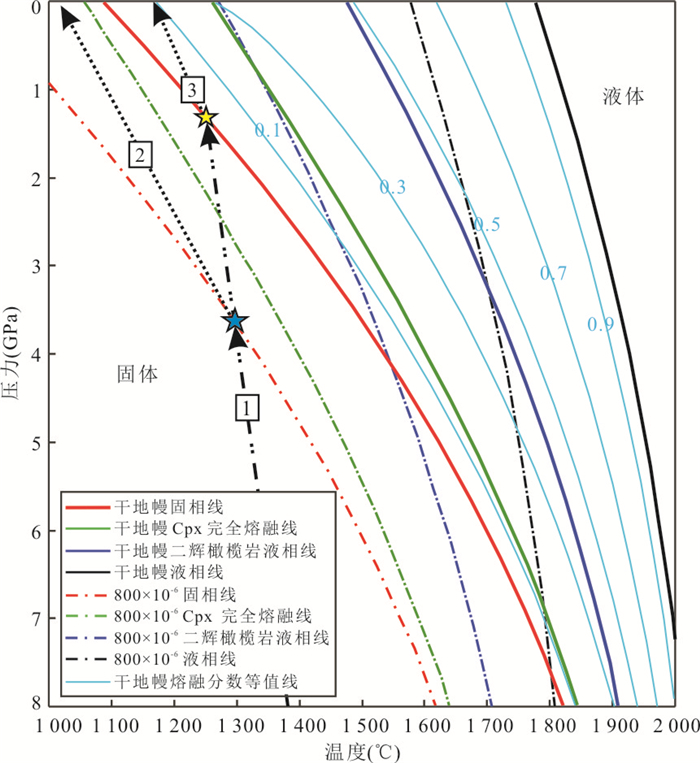
 下载:
下载:
